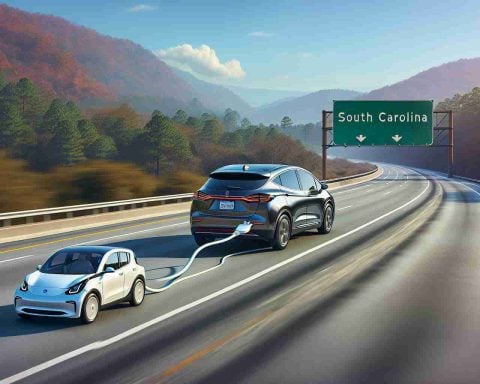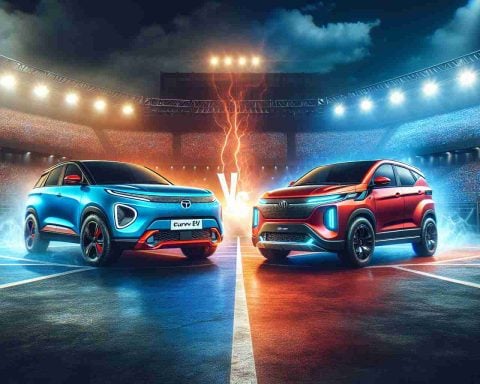- South Carolina has a low number of EV charging stations, hindering its green energy potential.
- Sen. Larry Grooms advocates for gas station owners to install chargers, ensuring fair competition by limiting power companies’ market dominance.
- Duke Energy’s pilot program, which shares infrastructure costs among customers, exemplifies challenges faced by small businesses entering the EV sector.
- South Carolina missed a $70 million federal grant, highlighting the urgent need to improve EV infrastructure and move up from its current ranking of 40th in the country.
- The state’s future in green energy depends on collaboration between local businesses and energy policy reform.
South Carolina’s scenic highways may soon witness a silent revolution, but only if the state can accelerate its efforts in electric vehicle (EV) infrastructure. While the country speeds ahead, South Carolina trails in the race, lagging sorely behind in the number of EV charging stations. This shortage casts a long shadow over the state’s potential green future.
Enter Sen. Larry Grooms, a legislative crusader determined to shift gears. Grooms envisions gas station owners stepping up to fill the gap, free from competition against power companies bolstered by ratepayer subsidies. Having once owned convenience stores himself, Grooms resonates with entrepreneurs who hesitate to invest in chargers, wary of the formidable giants in the energy sector.
A notable example of this power play is a pilot program by Duke Energy, which installed 60 chargers, dispersing the infrastructure costs among their customer base. This strategy, Grooms argues, tilts the playing field against small businesses eager to join the EV movement. With a bill designed to level the landscape, Grooms aims to prevent power companies from monopolizing this nascent market.
However, time and opportunity remain precarious. South Carolina missed out on a golden $70 million federal grant due to political changes, leaving behind a significant untapped resource. This lost funding accentuates the urgency to act, as South Carolina ranks 40th nationwide in charging stations and falters in EV sales.
As the clock ticks, the question lingers: Can South Carolina rev up its commitment to green energy, allowing entrepreneurs to seize the wheel? A collaboration between local business and energy policy reform could navigate the state toward an electrified future, one charging port at a time.
Can South Carolina Supercharge Its EV Future?
How-To Steps & Life Hacks: Implementing EV Infrastructure
1. Federal and State Grants: Seek out new federal and state programs offering grants for EV infrastructure development. These are often aimed at alleviating initial costs for small businesses.
2. Community Partnerships: Engage local governments for partnerships, providing incentives for businesses to install charging stations. For example, municipal programs might offer tax breaks or streamlined permit processes.
3. Leverage Technology: Use smart technologies to manage and optimize charging networks. Smart grids can help balance load and reduce operational costs.
4. Collaborative Models: Gas station owners could partner with tech startups specialized in EV charging systems to share expertise and reduce costs.
Real-World Use Cases: Lessons from Success
– California’s Leading Role: California serves as an exemplary case for South Carolina. It leads the U.S. in EV infrastructure with robust incentives for stations, resulting in increased EV adoption. California’s initiatives demonstrate how policy can foster public and private investment.
– Public-Private Collaborations in Norway: Norway’s partnership between government and business has led to the highest per capita EV ownership in the world. This model shows the potential of collaborative efforts in accelerating EV transitions.
Market Forecasts & Industry Trends
– According to reports, the global EV market is expected to reach $802.81 billion by 2027, growing at a CAGR of 22.6%. South Carolina could tap into this trend by investing in infrastructure and policy reform to attract EV manufacturers and tech companies.
– Industry experts (e.g., BloombergNEF) predict that by 2040, electric vehicles will comprise 55% of all new car sales globally. Adopting appropriate strategies now could place South Carolina as a prominent player in future EV markets.
Reviews & Comparisons: The EV Charging Station Landscape
– Cost Considerations: Installation costs for charging stations vary; Level 2 chargers may range from $2,000 to $5,000, while DC fast chargers can exceed $50,000. Understanding these differences is crucial for potential investors.
– Providers: Key players like ChargePoint and EVgo offer different pricing and service models. Comparing these could help businesses determine the best fit for their needs.
Controversies & Limitations
– Ratepayer Subsidies: The use of ratepayer money to fund energy corporations’ EV initiatives raises ethical concerns on fairness and market dynamics, especially for small businesses.
– Missed Federal Grant: The political landscape’s impact on resource allocation accentuates how vital it is for states to align with federal green energy goals.
Security & Sustainability
– Cybersecurity Risks: With increased connectivity, charging stations could be potential targets for cyberattacks. Investing in secure network solutions is critical.
– Sustainability: Pursuing renewable energy-powered charging stations can enhance sustainability efforts and appeal to eco-conscious consumers.
Insights & Predictions: South Carolina’s Path Forward
– Local Legislation: Adapting state laws to support business involvement in EV infrastructure can speed up South Carolina’s transition to electric mobility.
– Public Awareness Campaigns: Fostering a cultural shift towards greener transport options through educational initiatives and marketing campaigns.
Pros & Cons Overview
Pros:
– Economic opportunities through job creation and new investments.
– Environmental benefits from reduced emissions.
Cons:
– Initial high investment for businesses.
– Potential pushback from traditional energy sectors.
Actionable Recommendations
1. Engage in Advocacy: Support policies that encourage the democratization of EV infrastructure.
2. Invest in Training Programs: Prepare the workforce with skills needed for EV-related jobs.
3. Innovate Financing Models: Explore leasing options or cooperative models to reduce upfront costs.
4. Monitor Industry Trends: Stay informed on the latest EV developments to make timely, strategic decisions.
For more information on enhancing EV infrastructure, visit the U.S. Department of Energy.












